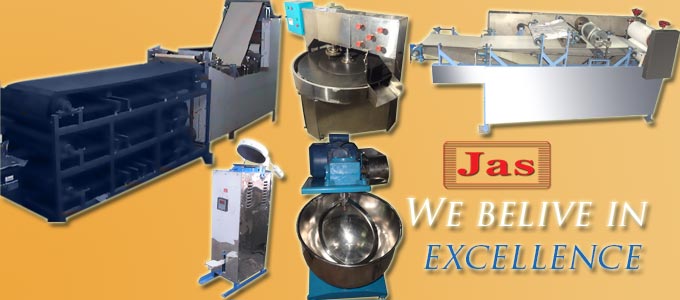

Chapati is made of whole meal flour and it is the staple food north Indians, where rice is eaten in relatively smaller quantities, towards the end of a meal. Freshly made, crisp chapatis are eaten straight off the fire, with a hot temperature vegetable or meat curry and a dal.
Some people like to smear each chapattis with a thin layer of ghee, immediately after it comes off the fire. Though chapatis tastes lovely with ghee, the thin chapatis are also called 'phulka'.
These JAS brand foot operated semi automatic chapati maker can produce up to 400 to 500 chapati per hour. Production capacity is depending upon skill of the chapati maker operator. The Foot operated Semi automatic Chapati, roti maker machine provides ease to use and cleaning, saves labor costs and ensures product uniformity.
We offer roti, chapati maker high quality roti, chapati, phulka to enjoy the natural aroma and flavor of wheat. It is design to be installing in supermarkets, tourist villas, suburbs and direct sale to the public, hotels, restaurants, hostels. Chapati maker is produce in all contacting parts are food grade. Temperature is adjustable.
Plug in the machine and allow it to heat.
↓
Place the ball of dough for one chapati, not in the middle but near the hinge of the chapati maker.
↓
Quickly press the top down on your dough to flatten it into the circular shape. (Don't let the top stay down, open it right away).
↓
Then puff the chapati just like you would on your stove.
Take chapati flour (wheat flour) with water at room temperature prepare the desired amount of dough either with help of jas dough mixer (floor kneading machine) or manual. After that, divide the dough into peach-size balls either with help of jas luva cutting machine or manual.
Now, start the jas brand roti maker set the thermostatic control at desired amount of temperature and starts the LPG burner, which is fitted with the machine. After getting desired temperature, the thermostatic control will be cutting out the power supply. After that please put dough into peach-size balls between two non-stick plates the press the foot operated pedal thus upper plate came nearest to lower plate the dough will get desired size because of the weight of the upper plate and heat from both side will cooked then when both sides are done, then the colour changes on the top and bottom and bubbles appear take off the pressure on the paddle then upper plate will be go up side then use kitchen tongs (chimta) to remove the roti from the non stick plates. Hold the cooked chappati over a medium flame and it will puff up immediately. Turn quickly to flame the other side. Most important is taking care that the edges are well cooked.
It is manual foot operated chapati, roti making machine thus it is depend on the working efficacy of operator but tentative production capacity is 500 to 600 chapati, phulka, roti, and paratha per hour.
Commercial chapati maker Jas-FCM-695 consist with aluminium cast with non-stick coating plates, lower plate is heated by liquefied petroleum gas and upper plate is heated by 1.5 kW electric heater, temperature is controlled by thermostatic control and thickens is adjusted by adjustment guide which is given on the back side of the chapati maker. Complete unit is mounted on fabricated angle stand and cover with stainless steel sheets.